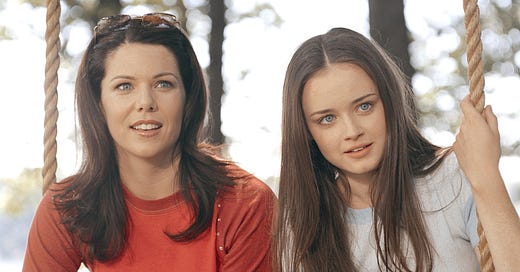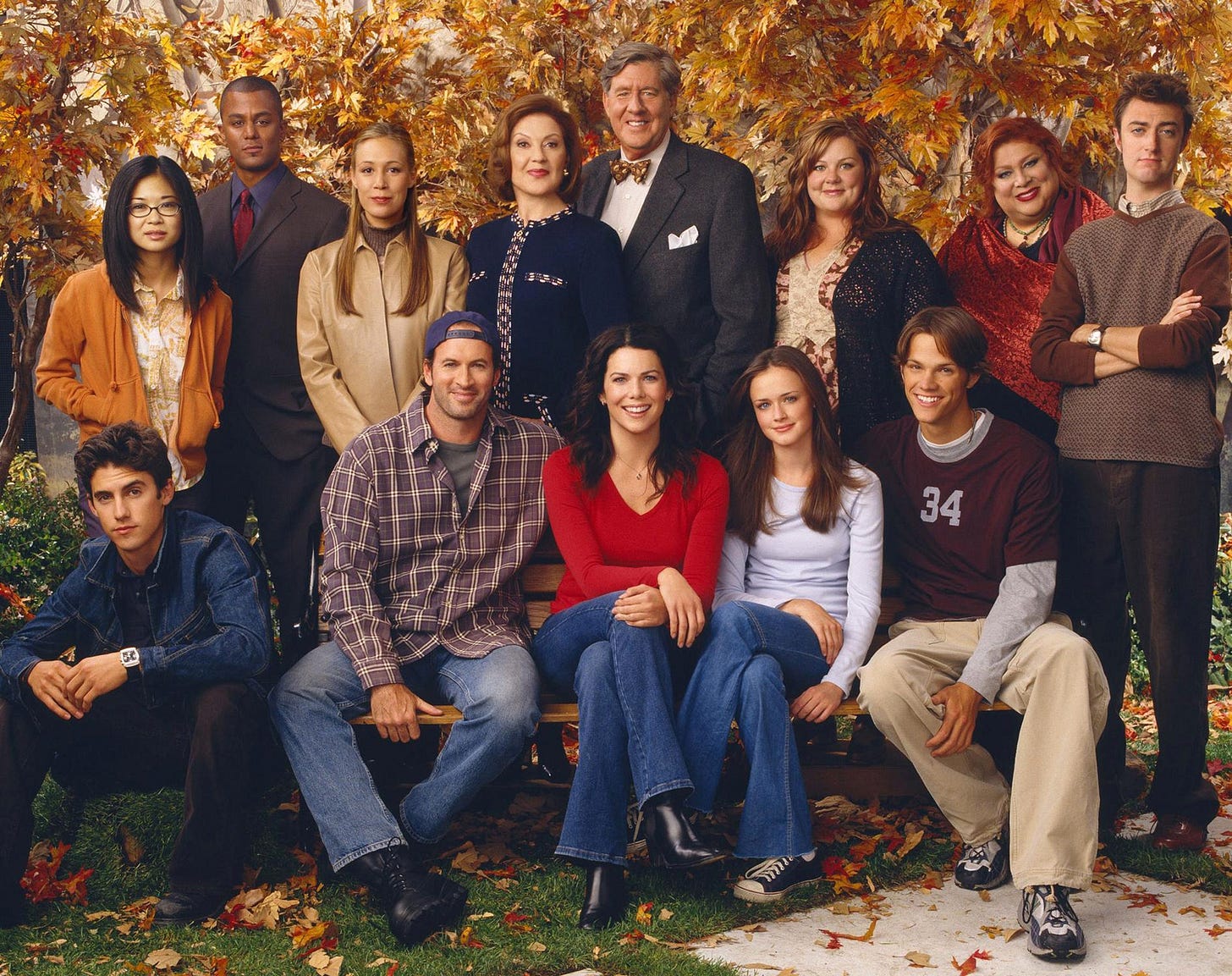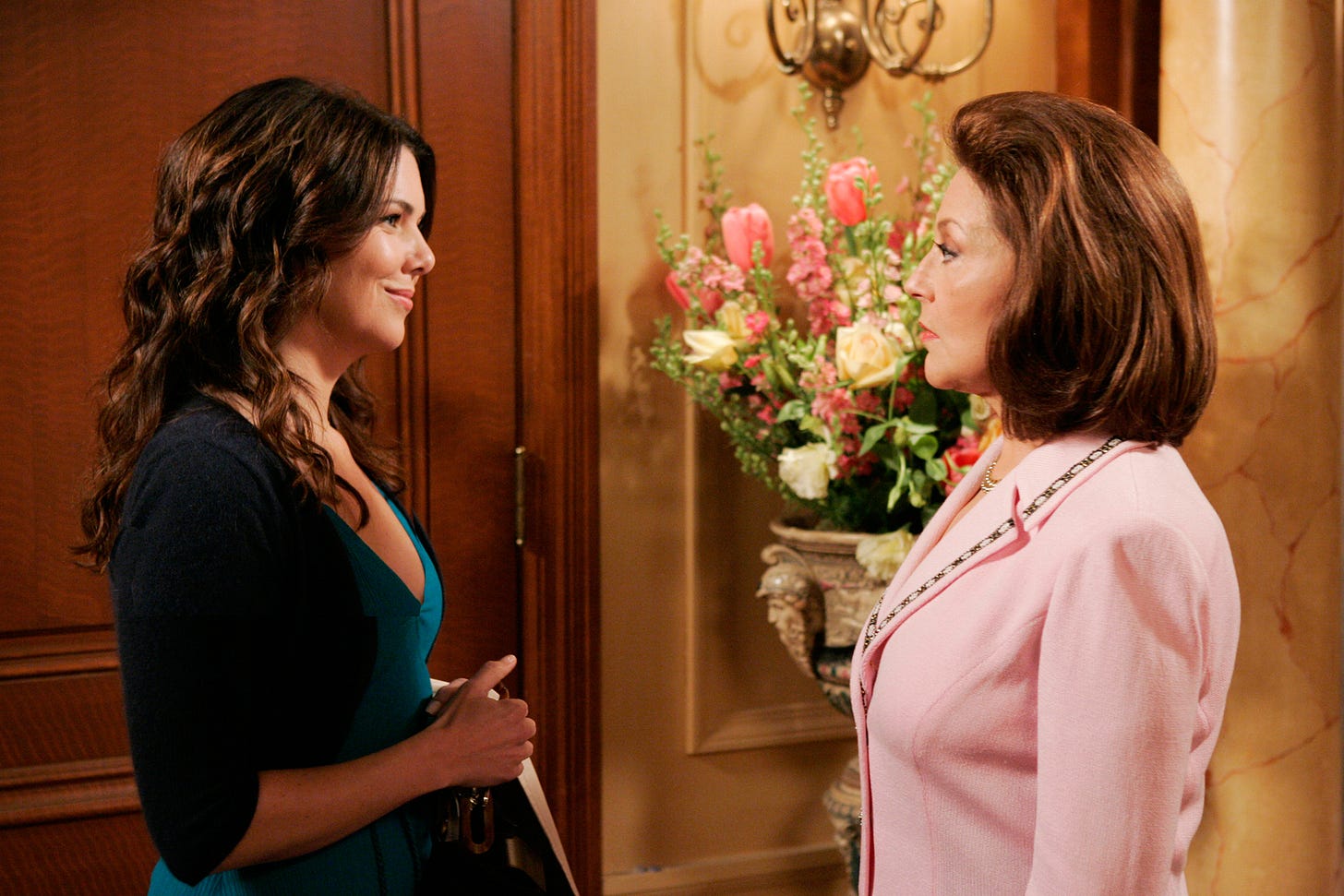Welcome to A Narrative of Their Own, where I discuss the work of 20th century women writers and their relevance to contemporary culture.
If you enjoy reading essays on literature, as well as reviews of great books and recommended reading, please consider a free or paid subscription.
*Trigger warning: contains references to mental health and suicide*
What I love the most about researching women’s narratives of the twentieth century is when I come across connections to contemporary culture and women’s lives now. In fact, that was the very premise I began with when I started this newsletter: not only did I want to celebrate the women writers of the modernist era, I also wanted to make connections to the ways we live now, and their continued influence on both women’s writing and contemporary women’s lives.
As I have been immersed in research into Sylvia Plath and her relationship with her mother lately, a connection occurred to me with the early 2000’s TV series Gilmore Girls, which I avidly watched with my two kids several years ago. The show originally aired between 2000-2007; we watched it the second time around when it hit Netflix, and many of its aphorisms have become the bedrock of our jokes and conversations at home. We often say that it would be our Mastermind specialist subject, were we ever to apply to the show!
If you have never seen the series (and seriously- just stop reading and go watch it)- it was created by Amy Sherman-Palladino and starred Lauren Graham and Alexis Bledel as mother and daughter Lorelai and Rory Gilmore. The story line is built around the fact that Lorelai fell pregnant to her high school boyfriend at the age of sixteen, hence she and her daughter Rory, who turns sixteen at the start of the series, have only sixteen years between them. They are best friends (though fight more like sisters) and live in the cutest small, fictional town of Stars Hollow.
A whole cast of characters also populate the town, including Luke, the local coffee shop owner; Sookie, Lorelai’s best friend and work colleague; and Rory’s best friend, Lane. There is also the ever-present parents that Lorelai left behind, wealthy Richard and Emily Gilmore. Emily is almost the third Gilmore Girl, and is wonderfully played by Kelly Bishop.
The show ran for a total of seven seasons (plus a somewhat disastrous reboot ten years on in 2014, A Year in the Life), following Rory as she gains a place in prestigious private school Chilton, navigates school friends, college, boyfriends, and her own academic ambitions, whilst Lorelai builds her own business, fights with her mother, and has several disastrous relationships.
Rory is a huge reader (there are whole YouTube videos and TikTok threads around reading the books mentioned in the series, which amount to over 300), and others have written of the prevalence of Plath’s writing within the series’, as well as the cultural commentary around her death.
In fact, Sylvia Plath is one of the most referenced writers within Gilmore Girls, with Rory often pictured reading her books, but the dialogue involving ‘jokes’ around the writer and her books are even more so. Sadly, many of these reference Plath’s depression and suicide (hey, I said I loved the series, I didn’t say it was perfect). It’s interesting to consider the show in 2025, in fact, because originally it appeared to be pretty subversive, with a feminist message: a young woman can bring up a child all by herself and they can both turn out just fine.
But returning to the show now, some of the writing has dated. On more than one occasion, there are examples of shaming or judgement of other female characters for their behaviour; there isn’t much in the way of diversity within the cast; and there is also a false sense of ‘poverty’ throughout, with the insistence that Lorelai has chosen to make it on her own, without her parents’ money. However, whenever the going gets tough, Lorelai’s parents can and do bail her out, funding both Rory’s private school education, and later Yale, and there is a general sense that they are often ‘playing’ at poverty.
In relation to Plath, the show often stigmatises mental health, such as when Lorelai advises Rory against putting Plath down as an influence on her college application:
LORELAI: You can evaluate a significant experience that’s had an impact on you…or you can write about a person who has had a significant influence on you.
RORY: You?
LORELAI: Or one of your authors, Faulkner or…
RORY: Or Sylvia Plath.
LORELAI: Hm, might send the wrong message.
RORY: The sticking her head in the oven thing?
LORELAI: Yeah. Although she did make her kids a snack first, shows a certain maternal instinct.
This is obviously reductive and used for humour, and there are several references to Plath’s suicide. In one episode, reference is made to Plath’s method of suicide, with Lorelai quipping: “hey, did anyone ever think that Sylvia Plath wasn’t crazy, just cold,” after they have spent a freezing night with a broken window.
Lorelai often makes light of Plath and her struggles, but there are further examples of the attitude to mental health which were perhaps less talked about in the early 'aughts. For example, when Rory telephones her mother to inform her that she’s been asked to see a therapist at Yale, Lorelai’s disapproving reaction evidences her prejudice against undertaking therapy. Similarly, in the (never-to-be-talked-about reboot), A Year in the Life, Emily persuades a reluctant Lorelai to attend therapy with her, where they decide they are not really the “sort of people” who have therapy.
In a further connection to the writing of Plath, Lorelai questions Rory’s decision to attend the party of a Chilton girl, after the snobbish students have been merciless in looking down on her:
Lorelai: Madeline’s having a party.
Rory: I’m going to go.
Lorelai: You’re going to a Chilton party?
Rory: Yes, I am.
Lorelai: Honey, why don’t you just stay home and read The Bell Jar? Same effect.
All this to say: some of the ‘jokes’ within the show have aged; we are hopefully all both more aware of- and tolerant towards- mental health, particularly when it comes to young women.
However, the reason I felt compelled to write about the Plath’s and the Gilmore’s after being knee-deep in research on Plath and her own mother, was because of the connections that are not referencing Plath or her books within the show, but which I found mirrored the women’s experiences.
As I discussed in my essay on Aurelia, Sylvia, and the psychology of ‘mother blaming’ recently, Aurelia stated that she shared with her daughter an almost too-close relationship; one she referred to as “psychic osmosis.” Sylvia in fact ‘escaped’ her mother’s closeness by moving to England- first as a Cambridge student on a Fulbright scholarship, and then later, by marrying English poet Ted Hughes. It appeared that she needed this separation in order to develop her own self, often referencing her mother’s suffocating influence through her writing, and through her discussions with her psychiatrist Dr Ruth Barnhouse.
Similarly, Lorelai and Rory share something of a psychic osmotic relationship.
Effectively growing up together, they are hardly apart, meaning when Rory eventually leaves for college, she ends up choosing the much closer Yale than Harvard, where she had originally intended to study. On her first night in her dorm, her mother sleeps on the floor as she cannot bear to be separated from her mother (an example of the “Momism” suggested by psychoanalysts in the mid-twentieth century).
Mother and daughter share their experiences and relationships within the show, which is both lovely…and perhaps, particularly in the case of Lorelai’s often overbearing need to know all about Rory’s life, just a bit too much. She insists that Rory even tell her when she is ready for her first sexual encounter. She also shares much of her own relationship woes with her daughter, and it does feel that she wishes to control the men in Rory’s life, as well as where she studies, and so on. She makes it clear on several occasions that she doesn’t approve of either of Rory’s choices: the young teenage rebel Jess, or the rich Yale student, Logan.
At one point, Rory drops out of Yale for several months, becoming despondent about her future after her rich boyfriend’s father, a huge newspaper magnate, tells her she has no future as a journalist (her dream). This is following an internship on one of his smaller newspapers, and Rory wonders to her mother what else she could do if she couldn’t write or work as a journalist or foreign correspondent as they have always planned.
She has something of a ‘breakdown’ by walking out of an exam and withdrawing from academic life (very similar to Plath and other women at Smith around the same time), showing the incredible pressure of such academic institutions. Although she doesn’t do anything as drastic as Plath’s attempted suicide, she does put space between herself and her mother’s claustrophobic relationship and moves into her grandparents’ pool house.
Rory’s whole academic life has been as a straight A student up to this point; she has garnered everything she has tried for. Eventually returning to Yale and her mother’s home, she then gets rejected over the summer just before graduation for the writer’s programme she had counted on getting into. She returns home and goes to bed, where her mother finds her and has to talk her down from the edge, convincing her that something positive will show up. Again, this mirrors Plath’s return from Mademoiselle, New York, in the summer of 1953, when a disillusioned Plath discovered her own rejection from a prestigious writing programme, and made her first suicide attempt.
As I thought about this more, there were countless similarities between the two Gilmore girls and Plath and Aurelia. Rory grew up in a household with no father at home, and although he is in her life, this is sporadic. Lorelai and Rory are so close because they effectively grew up together, and spent all of their time socialising with one another, enjoying the same interests such as music, books and classic movies. Similarly, due to the untimely death of Otto Plath, and due to sharing many of the same interests such as music, art and writing, Sylvia and Aurelia also socialised closely, leading to the “psychic osmosis” mentioned earlier.
And then we come to Emily Gilmore - a Smith girl like Sylvia - who met Richard whilst he was at Yale, “stealing” him from his fiancée. Some critics have noted that Emily’s character would likely have been studying at Smith under what was termed a “MRS degree”, a colloquial, slang term, used to refer to a young woman who attended college for the primary purpose of finding a husband, rather than to pursue academic or career ambitions.
This can be seen in the film Mona Lisa Smile, in which many of the young female students are prepared to drop out of their courses once they meet an eligible man to marry.
As women were not accepted at Yale college until 1969, female students from highly regarded women’s colleges such as Smith were regularly bussed in to Yale mixers, to enable the male and female students to mingle.
Emily, we are told in the show, majored in History, and likely met Richard during an inter-school event. But throughout the series’, she emits an intelligent and no-nonsense approach to life. Whilst she often appears snobbish towards Lorelai’s life choices, she is a product of her upbringing, gender and class. Although she has followed the expected path of a society wife, she remains a strong and fiercely independent woman.
In this, we can see Aurelia Plath’s life trajectory. Although not from a wealthy background or marriage such as the fictional Emily, Aurelia nonetheless followed convention. She obeyed her father’s wishes when it came to her choice of studies, and then gave up her teaching job as soon as she married Otto Plath, as he wished for her to be a housewife. She confesses in Letters Home that she enjoyed her job, indicating that she didn’t necessarily wish to give up work, but submitted to her husband’s wishes.
As I have been deep-diving into research on Plath and other female writers, it has reminded me of how relevant the societal and cultural mores of when they were written are, to both the author’s and their character’s lives.
It may be that the connection between the Plath’s and the Gilmore’s are no more than mere coincidences, driven by the fact that I love them both. Certainly, what it has reminded me of is that even a show about contemporary women, made in the early 2000’s, contains discussions, language and ‘humour’ which is already dated, particularly around the issue of mental health.
What I would really love to know is whether Amy Sherman-Palladino intended for these connections between the women in her fictional world and the ones they read in the show, leading her to put so many references to Plath and her writing in the narrative.
Amy- if you’re reading this- I’d love to know! We’re your biggest fans! 😂
If you’re new around here, I usually write about all things women literature related. Please consider a free or paid subscription - your support helps keep this newsletter afloat!








I think there is something here. Rory’s “fatal flaw” is that she is not really able to assimilate failure. Each setback must be a disaster. I mean, sure, she’s a teenager. But this depth of feeling, this indulgence of despair, does strike me as very Plath-like.
I think this might be some of the fandom’s frustration with Rory - because it’s a light drama, none of the darkness can be allowed to stick. She passes through these valleys, but seems to emerge unscathed each time, which doesn’t quite strike as authentic. The poets and writers who felt things so deeply were bruised by life. Obviously I am not suggesting that plath’s fate was inevitable or a casual by-product of art. But the suffering that produced the art also left scars, and the fact that Rory escapes these feels perhaps a little unnatural
I have never seen the Gilmore Girls, but I think I will have to now. I'm very interested in your Sylvia Plath research and articles, and their psychic osmosis relationship. There are probably many more examples of psychic osmosis cropping up in other mother/daughter experiences the more you look and the more you read.